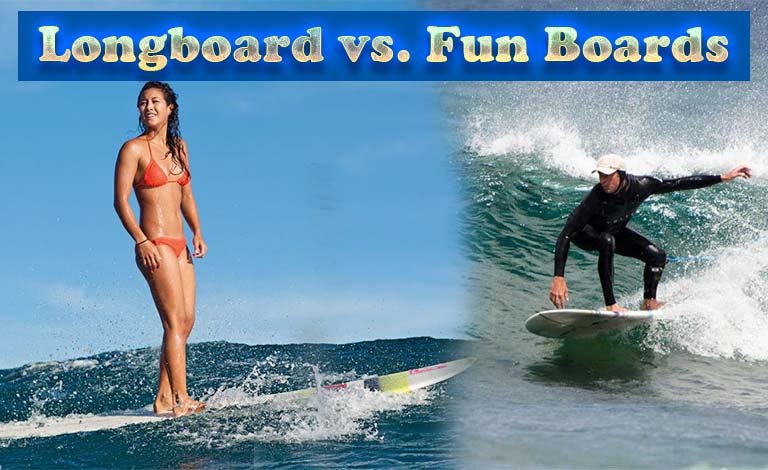As an Amazon Associate I earn from qualifying purchases.
This post contains affiliate links.
In the world of surfing, the choice of board can significantly impact one’s experience on the waves. Among the myriad options available, two popular choices stand out: the longboard and the fun board. Both offer unique advantages and cater to different surfing styles and preferences. In this comparative article, we delve into the distinctions between longboards and fun boards, exploring their designs, performance characteristics, and the type of surfing they are best suited for.

Understanding Longboards:
Longboards, often referred to as “logs” or “tankers,” are characterized by their elongated shape and substantial volume. Traditionally, longboards were the hallmark of surfing, tracing their roots back to the early days of wave riding. These boards typically range from 9 to 12 feet in length, providing ample buoyancy and stability on the water. The extended length allows surfers to catch waves early and glide effortlessly along their faces, making longboarding an excellent choice for riders of all skill levels.
Longboards offer a smooth and relaxed surfing experience, with riders enjoying the ability to hang ten and perform graceful maneuvers such as noserides and drop knee turns. Their generous volume enables paddling efficiency, making them ideal for catching smaller waves or riding crowded breaks. Additionally, longboards excel in slower, mushier waves, where their buoyancy and glide compensate for the lack of power in the wave.
Exploring Fun Boards:
Fun boards, also known as hybrid boards or mini-mals, represent a versatile middle ground between longboards and shortboards. These boards typically range from 7 to 9 feet in length and feature a wider and thicker profile compared to shortboards. Fun boards are designed to offer a balance between stability and maneuverability, making them suitable for a wide range of surfing conditions and skill levels.
The versatility of fun boards lies in their ability to adapt to varying wave conditions and surfing styles. With a design that combines elements of both longboards and shortboards, fun boards offer greater maneuverability and responsiveness while retaining some of the paddling ease and stability characteristic of longboards. This versatility makes fun boards an excellent choice for surfers looking to progress beyond the beginner stage or for experienced riders seeking a board that can handle a variety of wave types.
Design and Performance Characteristics:
When comparing longboards and fun boards, several design and performance characteristics come into play. Longboards, with their elongated shape and substantial volume, prioritize stability and glide. They feature a rounded nose and a wide, rounded tail, providing ample buoyancy and lift on the water. Longboards typically have a single fin setup, although some modern variations may incorporate multiple fins for added maneuverability.
In contrast, fun boards feature a more compact design with a slightly narrower profile compared to longboards. They often have a rounded nose for easy paddling and a rounded square tail for improved maneuverability. Fun boards typically come with a thruster or quad fin setup, enhancing their responsiveness and allowing for tighter turns and better control in steeper waves.
Choosing the Right Board for You:
When deciding between a longboard and a fun board, it ultimately boils down to personal preferences, surfing style, and skill level. Longboards are ideal for beginners due to their stability and ease of paddling, making the learning process more accessible and enjoyable. They also suit riders who prefer a more laid-back approach to surfing, emphasizing style and grace over high-performance maneuvers.
On the other hand, fun boards appeal to surfers seeking a balance between stability and maneuverability. They are versatile enough to handle a wide range of wave conditions, from small, mushy waves to more powerful, hollow breaks. Fun boards are suitable for intermediate to advanced surfers looking to refine their skills and explore different aspects of wave riding, from carving and cutbacks to noserides and bottom turns.
Pros and cons of Longboards
PROS
CONS
Pros and cons of Funboards
PROS
CONS
As an Amazon Associate I earn from qualifying purchases.
Leave a Reply